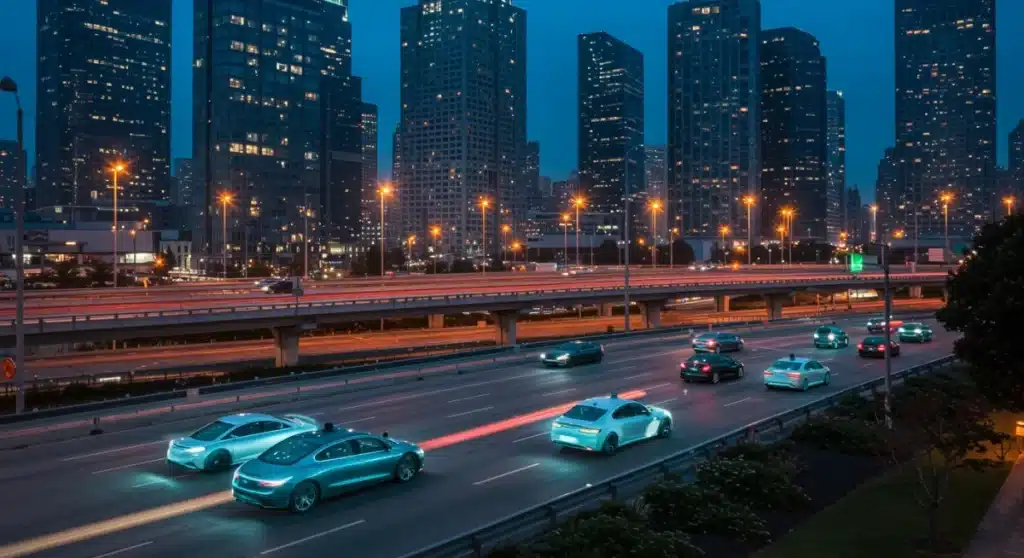Future of Transportation: 10% Autonomous Vehicle Adoption by 2032 in US

The United States is on track to achieve a 10% adoption rate for autonomous vehicles by 2032, signaling a transformative shift in the nation’s transportation landscape driven by ongoing technological advancements and evolving regulatory frameworks.
The Future of Transportation: Predicting a 10% Adoption Rate for Autonomous Vehicles in the US by 2032 is no longer a distant dream but an impending reality. This significant projection signals a profound shift in how Americans will commute, travel, and interact with transportation systems in the coming decade. What will this mean for our cities, our economy, and our daily lives?
The Current Landscape of Autonomous Vehicle Development
As of late 2023, the autonomous vehicle (AV) industry continues to advance rapidly, with numerous companies investing heavily in research and development. From Waymo’s robotaxi services expanding in major cities to Cruise’s recent operational challenges, the journey toward widespread adoption is dynamic and multifaceted. Current deployments are largely confined to geo-fenced areas, showcasing the incremental, yet steady, progress being made.
Key players in the automotive and tech sectors are pushing the boundaries of what’s possible. Companies like Tesla are refining their advanced driver-assistance systems (ADAS) which, while not fully autonomous, lay the groundwork for future capabilities. Meanwhile, dedicated AV companies are focusing on Level 4 and Level 5 autonomy, aiming for vehicles that can operate without human intervention under specific or all conditions.
Technological Milestones and Challenges
Recent breakthroughs in sensor technology, artificial intelligence, and real-time data processing have significantly improved AV performance. However, challenges persist, particularly concerning adverse weather conditions, complex urban environments, and cybersecurity threats. The robustness of perception systems and decision-making algorithms remains a critical area of focus for engineers and researchers.
- Sensor Fusion: Integrating data from lidar, radar, cameras, and ultrasonic sensors for a comprehensive environmental understanding.
- AI & Machine Learning: Developing sophisticated algorithms for predictive behavior and real-time decision-making.
- Mapping Technology: Creating highly detailed and constantly updated maps essential for precise navigation.
- Cybersecurity: Protecting AV systems from potential hacking and data breaches.
Understanding the 10% Adoption Projection by 2032
The prediction of a 10% adoption rate for autonomous vehicles in the US by 2032 reflects a growing consensus among industry analysts and market researchers. This figure encompasses various forms of AVs, including privately owned cars, robotaxis, and autonomous shuttles. This isn’t just about individual car sales; it also factors in the growth of mobility-as-a-service (MaaS) models powered by self-driving fleets.
Several factors contribute to this projection, including anticipated regulatory clarity, continued technological maturation, and increasing consumer familiarity and trust. The economic benefits, such as reduced labor costs in logistics and ride-hailing, are also powerful drivers. This forecast suggests a significant, though not complete, integration of AVs into mainstream transportation.
Drivers of Accelerated Adoption
The pace of adoption will largely depend on overcoming current hurdles and leveraging key accelerators. Government incentives, infrastructure investments, and public education campaigns will play crucial roles. The generational shift in attitudes towards car ownership versus mobility services could also fuel this growth.
- Regulatory Frameworks: Clear federal and state guidelines are essential for widespread deployment.
- Cost Reduction: As technology scales, the cost of AVs is expected to decrease, making them more accessible.
- Consumer Acceptance: Building public trust through proven safety records and positive user experiences.
- Infrastructure Readiness: Smart city initiatives and V2X (Vehicle-to-Everything) communication advancements.
Regulatory and Policy Developments Shaping the Future
The regulatory landscape for autonomous vehicles in the US is continually evolving, with both federal and state governments grappling with how to safely integrate this technology. Federal agencies like the National Highway Traffic Safety Administration (NHTSA) are developing performance standards and guidelines, while states are implementing diverse legislative frameworks. This patchwork approach currently presents challenges but is slowly converging towards more standardized regulations.
Recent legislative proposals aim to streamline testing and deployment processes, while also addressing critical issues such as liability and data privacy. The push for a unified national framework is gaining momentum, which could significantly accelerate the deployment timelines and foster greater consistency across state lines. Industry stakeholders are actively engaging with policymakers to shape these crucial regulations.
Key Regulatory Milestones and Hurdles
The path to widespread AV adoption is paved with regulatory milestones. The establishment of clear legal frameworks for operations, testing, and accident liability is paramount. Overcoming public concerns about safety and ensuring equitable access to AV technology are also critical policy considerations.

The complexity of integrating AVs into existing transportation infrastructure requires careful planning and robust policy development. Policymakers are also exploring how AVs can contribute to broader societal goals, such as reducing traffic congestion, lowering emissions, and improving accessibility for underserved populations.
Economic and Societal Impacts of Autonomous Vehicle Integration
The integration of autonomous vehicles promises to bring about significant economic and societal transformations. Economically, this includes the creation of new industries and job roles, particularly in software development, AI, and maintenance of AV fleets. Conversely, there will be shifts in traditional sectors like professional driving. The logistics industry stands to benefit immensely from optimized routes and 24/7 operational capabilities, potentially lowering shipping costs.
Societally, AVs could lead to a dramatic reduction in traffic accidents, as human error is a primary cause. This would save countless lives and reduce healthcare burdens. Furthermore, increased mobility for the elderly and disabled, more efficient use of urban space due to reduced parking needs, and a potential decrease in traffic congestion are all anticipated benefits. The autonomous vehicle adoption US trend is set to redefine urban planning and personal freedom.
Transformative Effects on Cities and Lifestyles
Cities could see a reduction in the need for vast parking lots, freeing up valuable real estate for housing, parks, or commercial development. Commutes could become more productive or relaxing, as passengers are no longer required to drive. However, these changes also bring challenges, such as managing potential job displacement and ensuring equitable access to AV services.
- Reduced Accidents: Significantly fewer collisions due to elimination of human error.
- Enhanced Mobility: Greater independence for non-drivers, including seniors and individuals with disabilities.
- Urban Planning: Redesigned cities with less emphasis on parking and more on green spaces.
- Productivity Gains: Commuters can utilize travel time for work, leisure, or rest.
Consumer Perception and Trust: A Critical Factor
Public perception and trust remain pivotal to achieving the 10% adoption rate by 2032. While early adopters are eager to embrace the technology, a significant portion of the population expresses skepticism or fear regarding self-driving cars. High-profile incidents, even isolated ones, can severely impact public confidence. Therefore, transparent communication, robust safety records, and positive user experiences are paramount to shifting public sentiment.
Educational campaigns detailing the safety features and benefits of autonomous vehicles will be crucial. Test drives, public demonstrations, and gradual rollout strategies in controlled environments can help demystify the technology and build familiarity. As more people experience AVs firsthand, comfort levels are expected to increase, paving the way for broader acceptance. The narrative around AVs needs to emphasize safety and convenience.
Building Confidence Through Transparency and Experience
For the Future of Transportation: Predicting a 10% Adoption Rate for Autonomous Vehicles in the US by 2032 to materialize, companies must prioritize transparency regarding their safety protocols, testing methodologies, and incident reporting. Public trust is earned through consistent performance and clear communication, not just technological prowess. Showcasing real-world benefits and addressing concerns directly will be key.
The role of media in shaping public opinion is also significant. Accurate and balanced reporting on AV developments, highlighting both successes and challenges, will be vital. As autonomous technology becomes more commonplace, the initial novelty and apprehension are expected to give way to routine acceptance, much like the adoption of other transformative technologies throughout history.
Challenges and Roadblocks to Achieving 10% Adoption
While the 10% adoption target by 2032 is ambitious, it is not without its significant challenges. Technical hurdles, such as perfecting AV performance in all weather conditions and complex urban scenarios, still require substantial R&D. The cost of manufacturing AVs, particularly those with higher levels of autonomy, remains a barrier for mass market penetration, though economies of scale are expected to drive prices down over time.
Legal and ethical considerations, including liability in accident scenarios and data privacy concerns, are also complex issues that need clear resolutions. Furthermore, public resistance, as discussed, and the need for significant infrastructure upgrades to fully support AV networks pose substantial roadblocks. Addressing these multifaceted challenges will require concerted effort from technology developers, policymakers, and urban planners.
Overcoming Hurdles for Widespread Integration
To overcome these challenges, a collaborative approach is essential. This includes cross-industry partnerships, government funding for research and infrastructure, and continuous public engagement. Investing in robust testing frameworks and clear certification processes will also be critical to ensure safety and build consumer trust. The journey to a fully autonomous future is incremental, demanding persistent innovation and problem-solving.
- Technological Refinement: Ensuring reliability in diverse and unpredictable driving conditions.
- Manufacturing Costs: Reducing the production cost of advanced AV components and systems.
- Legal Clarity: Establishing definitive laws for liability and operational standards.
- Infrastructure Investment: Upgrading roads, signage, and communication networks to support AVs.
| Key Aspect | Brief Description |
|---|---|
| 10% Adoption Rate | Projected market penetration for autonomous vehicles in the US by 2032, including private and fleet usage. |
| Technological Progress | Advancements in AI, sensors, and mapping are driving AV capabilities forward, despite remaining challenges. |
| Regulatory Evolution | Governments are developing frameworks for safe deployment, with a push for national standardization. |
| Societal Impact | Anticipated benefits include reduced accidents, increased mobility, and urban space optimization. |
Frequently Asked Questions About Autonomous Vehicle Adoption
The 10% adoption rate by 2032 likely encompasses Level 3 (conditional automation) and Level 4 (high automation) vehicles. While Level 5 (full automation) remains the ultimate goal, widespread deployment by 2032 will primarily involve AVs capable of handling most driving tasks under specific conditions or in defined operational design domains.
Autonomous vehicles are expected to complement and potentially transform public transportation. Autonomous shuttles and robotaxis could provide first-mile/last-mile solutions, improving connectivity to existing transit hubs and expanding service to underserved areas. This integration aims to create a more efficient and accessible multimodal transportation network.
Primary safety concerns include the reliability of AV sensors and software in adverse conditions, the ability of AVs to predict and react to unpredictable human behavior, and cybersecurity vulnerabilities. Industry efforts focus on rigorous testing, redundant systems, and continuous software updates to address these challenges and build public trust.
Initially, fully autonomous vehicles may have a higher price point due to advanced technology. However, as production scales and technology costs decrease, affordability is expected to improve. Ride-hailing services using autonomous fleets could offer a cost-effective way for consumers to experience AV benefits without direct ownership, making the technology accessible to a broader demographic.
The insurance and liability frameworks for autonomous vehicles are still evolving. Current discussions suggest a shift in liability from the human driver to the AV manufacturer or software provider in certain scenarios. Insurers are developing new policies and models to adapt to this change, focusing on product liability and software performance rather than driver error.
What This Means
The projected 10% adoption rate for autonomous vehicles in the US by 2032 is more than a milestone in technological progress — it signals a structural transformation of mobility, urban planning, and economic ecosystems. As autonomous systems integrate into everyday transportation, we can expect a shift toward smarter commute patterns, optimized traffic flows, and reduced accident rates driven by AI-assisted decision-making. This reshaping of mobility has the potential to unlock productivity during travel, redefine workforce logistics, and influence how cities allocate public space.
However, the transition will require careful coordination between technology developers, regulators, and local communities to address safety standards, ethical data use, and infrastructure readiness. Insights from industry mobility outlooks like https://www.mckinsey.com/features/mckinsey-center-for-future-mobility/our-insights/autonomous-vehicles-moving-forward-perspectives-from-industry-leaders demonstrate how leading stakeholders are already framing autonomous vehicles not just as a product, but as a catalyst for systemic innovation across transportation networks.
Ultimately, the future of autonomous mobility hinges on proactive engagement and adaptive policymaking. As adoption accelerates, the benefits will extend well beyond convenience — shaping more sustainable urban environments, expanding access to transportation, and setting the stage for a new era of connected, intelligent infrastructure that supports long-term societal well-being.





